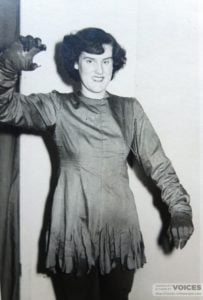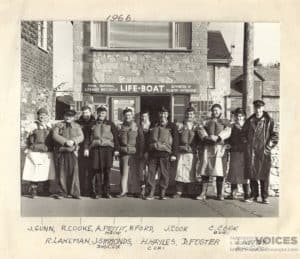Our pantomimes were always very well supported. So many people were in them and others came to watch. We used to go to Mrs Hans Hamilton’s house sometimes rehearsing for the pantomimes. I always remember this fire in the middle of the room.
Annette Haynes nee Holloway
Category Archives: Uncategorized
Betty Coates-Evans: Free Time Pantomimes, concerts, 1950s,

Mrs Hans Hamilton front right and Sam McDonald with cast from Guides and Brownies including Mollie Mallett and Effie Pitman centre stage :photo Mary Lord
We’d start about 6 months before the performance and often practise and rehearse 6 evenings a week. We’d give performances at Wilberforce Hall in Brighstone for 2 nights, 2 nights at West Wight School – there was a good stage there, 2 nights at Yarmouth at The Con Club.
Mrs Hans Hamilton used to write the words and play the piano too. Although she was one of the rich people in the town she worked really hard for the community. If she told you what to do, you did it! She didn’t stand any nonsense but it was such fun.
Effie Pitman was usually the Principal Boy – she had such good legs – , with Mollie Mallet.
So many people were involved. Barry MacDonald’s father used to play the drums for us, Malcolm Mallet the butcher, and Raich Doe( harbour master) used to build the scenery for us.
Betty Coates Evans b 1938
- Guide and Brownie Pantomime at the ‘Con Club’ 1950s
Sue Russell: Harbour, lifeboat, 1950s, 1960s
Our Father was lifeboat Coxswain for many years and the maroons were let off from our garden, under the clothes line. We always had to make sure the line was empty of clothes otherwise they would have gone up too. I was paid, I think it was two shillings and 6 pence, to time from when the maroons went off to when lifeboat left the harbour, which was a lot of money in those days. Sue Russell nee Hayles b 1940
Pauline Harwood: Harbour, old quay 1930s
I was left on the Quay with my Grandmother from London, – I wasn’t very old,- in a pram under the Spit and Lean. That was taken down when the coalyard was knocked into the Quay. Blakes Coalyard was handy for the blacksmith’s shop across the road.
Round the corner where the pigsties were and the steps used to go down to the sea my sister Audrey who was 7 years older than me used to take me and John down the steps and anybody dinghy that was there, we used to get in it and row somewhere. We used to do that then.
Pauline Harwood nee Hatch b1930
Eileen Smith: Harbour, Quay
On the Quay itself, the original Bullnose, before the alterations, there was a carpenter’s workshop, Harwoods stables where they kept the horse and cart for deliveries and a blacksmith’s forge. There was Blakes Coalyard and office, and Mr. Saunders charabanc garage that burnt down. At the end was the ‘Spit and Lean Club’, a 3 sided shelter from the weather where all the local chaps gathered to watch the goings on, and pass comments. Eileen Smith b 1921
Joan Cokes: Harbour, rowing 1920s, 1930s
My father was employed as a gardener in the Pier Hotel (now the George Hotel). He bought a boat in Lymington and rowed it back to Yarmouth on a slack tide.
I can remember rowing my father’s boat for him. He would ask me to take it alongside the harbour at high tide, from the hard by the boatyard – otherwise it would have been high and dry at low tide. I also used to row my father and a customer to go fishing off Black Rock – but he wouldn’t tell me or show me the fishing ‘marks’. Joan Cokes nee Cooper b 1918
Harbour: Jim Cooper 1920s – 1960s
It was a basic dinghy shape. They called it a ‘lanch’ the old boys, so that differentiated it from a rowing boat. It was bigger and it had a net board in the back. In the transom, six inches below, there was a net board about two foot wide which we used to lay the net on when we were shooting nets out the back of the transom. It was a very wide boat and the oars he used were about ten foot long, huge big ash oars, they weighed a ton, I couldn’t lift them.
In those days he made a little bit of a living on pout which these days is much maligned. ‘Sweet little pout’; my mum still says now, ‘Why can’t you get me a sweet little pout?’
It’s like a mini cod, the same flesh, same family. He used to catch those.
When we used to go out we used to row down to Fort Vic., go out in the tide. You remember those old iron wheelbarrow wheels with a spike in the middle? He used to have one of those, that was his anchor and a big bit of grass rope and he used to chuck that over and he used to have the oars ready. They’d get to where they wanted to go and drift back, and let a bit more rope out; so they stopped and then they fished, and all they used was line, about three or four hooks on the bottom and garden worms. They’d catch a few pout and then they’d run out, or they hadn’t caught one, then they’d trip the killock [small anchor]. Pull the anchor up a little bit, let it go, give it a shear with the oar now and again, and drift in the right direction to another bit of ground. And they’d do that all the way to Bouldnor. There was about three or four places where they stopped. And of course by the time you got to Bouldnor inshore, the ebb was down again, so you had the tide back the other way. Alec Cokes b 1945
Harbour: Jim Cooper 1920s -1960s
I used to spend a lot of time with my grandad, Jim Cooper, and he used to have these old rowing boats he used to row about fishing and things. He’d always done that. You’ve got to remember he was born in 1883. This was in the sixties and he was nearly ninety when he died. He used to go out, never very far, only to Bouldnor or down to Fort Vic. and somewhere in between. He went up the river a bit. Sid Kelleway was always up the river and they used to have their little territories. Grandad had two boats, one about eighteen foot long he used to stand up and row, and a small one he would stand up and row as well, pushing forward rather than pulling back on the oars, one foot slightly forward of the other one. If you stand with your feet parallel you go forward then you’ve had it, so he always had one foot slightly ahead of the other. You don’t see anyone do it now, but you could do, if you had the right boat and the right oars. Alec Cokes b 1945
Services: Laundry 1930s ,1940s, 1950s
At the end of Heytesbury Road was the Solent Steam Laundry. A very loud whistle was sounded there to mark the start and end of work shifts at 8.00, 12 noon, 1.00pm and 4.30 Eileen Smith nee Lansdowne b 1921
There were forty or fifty people who worked there, they were big employers. Alec
Cokes b 1945
My Mum used to send her sheets to the Laundry when she was first married. She didn’t have a washing machine. Ruth Mills nee Kelleway b 1945
My Grandad worked up the Laundry, and wanted me to go and work there but I didn’t fancy it. Brian Pomroy b 1937
Rodney Corbett: Services, Fire Brigade 1950s
Now my Uncle Ted as a young man was the ‘leader of the band’ of mostly builders who used to run with this handcart if anywhere was on fire. The handcart was kept in the Town Hall; they didn’t even have a horse. It must have been a very slow turn-out – to go round gathering the men in to run with the handcart. The handcart brigade would deal with anything round the town.
Just before the war they decided that Yarmouth would have to have an Auxiliary Fire Service team and Ted got ousted because it was all made up of Bucketts. Ted went off in a fit of pique and joined the Home Guard. In the war it became National Fire Service from Auxiliary, and after the war they were put back to the local Councils and then became the Isle of Wight Fire Service. When I joined, the original Fire Chief for the Island, Sullivan, was still there and how many Chiefs did I see? – dozens. Rod Corbett b 1943









